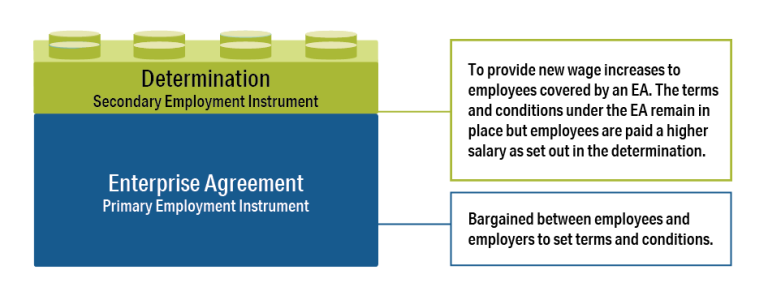Chapter 9: Employment instruments
Primary employment instruments
A primary employment instrument is a comprehensive arrangement used to set the majority of the terms and conditions for an employee.
Employees within the APS have their employment terms and conditions set by one of the following primary employment instruments:
- enterprise agreements [10] [11]
- Public Service Act (PS Act) determinations (sections 24 (1) and 24 (3))
- common law arrangements
- Australian Workplace Agreements.
As a proportion of the APS, enterprise agreement coverage decreased from 77.4% in 2021 to 74.5% in 2022. This was primarily due to the movement of over 6,000 employees to one of two new departments which preserved the terms and conditions of employees’ former enterprise agreements under a PS Act determination.
Employees in the newly created Department of Climate Change, Energy, the Environment and Water and the Department of Employment and Workplace Relations, along with Services Australia (established as a new agency in 2020) made up over 90% of employees with a PS Act determination as their primary employment instrument.
Only 0.5% of employees were covered by a common law arrangement or Australian Workplace Agreement that operated as the primary employment instrument. This proportion has remained relatively stable in the previous five years.
The Public Sector Workplace Relations Policy 2023 was released on 28 March 2023. It requires agencies to commence bargaining new enterprise agreements. As this occurs the use of determinations to set terms and conditions will decrease.
Table 9.1 provides a breakdown by classification of primary employment instrument coverage.
Table 9.1 Employees by primary employment instrument and classification, 2022
| Primary employment instrument | ||||
|---|---|---|---|---|
| Classification | Australian Workplace Agreements | Common law arrangements | Enterprise agreements | PS Act determinations |
| Graduate | . | . | 1,651 | 198 |
| APS 1 | . | . | 211 | 64 |
| APS 2 | . | 2,119 | 110 | |
| APS 3 | . | 7 | 7,111 | 4,328 |
| APS 4 | . | 59 | 14,640 | 11,526 |
| APS 5 | . | 56 | 17,814 | 4,215 |
| APS 6 | . | 87 | 29,155 | 7,298 |
| EL 1 | 1 | 116 | 26,780 | 5,049 |
| EL 2 | 1 | 63 | 12,049 | 1,947 |
| SES 1 | 2 | 244 | 22 | 1,968 |
| SES 2 | . | 69 | 5 | 562 |
| SES 3 | 1 | 15 | . | 113 |
| All employees | 5 | 716 | 111,557 | 37,378 |
Public Service Act determinations providing wage increases
As at 31 December 2022, 88 agencies had a PS Act determination in place to set salaries for non-SES employees while a nominally expired enterprise agreement (or other primary employment instrument) continued to operate. Over 130,000 employees, or 88% of the APS workforce were covered by these arrangements. This includes agencies that used a determination to implement a 3% wage increase under the Public Sector Interim Workplace Arrangements 2022.
As agencies bargain new enterprise agreements the use of determinations to set employees’ salaries will decrease.
Figure 9.1 Supplementation of salaries in an enterprise agreement (EA) using a determination

Individual flexibility arrangements and other supplementary arrangements
An individual flexibility arrangement is a written agreement between an employer and employee. It varies the effect of an enterprise agreement or an award on an individual basis and must result in the employee being better off overall.
Around 3% of employees had additional terms and conditions provided through the individual flexibility arrangement provision in their enterprise agreement. Table 9.2 shows that 73.6% of employees using these arrangements were at the EL 1 or EL 2 classification.
An individual flexibility arrangement can provide for a range of conditions such as pay and allowances, leave, income maintenance, flexible working arrangements, superannuation and subscriptions or memberships. A single individual flexibility arrangement may cover multiple arrangements.
The majority of individual flexibility arrangements (88.7%) were used to provide pay and allowances. The second highest usage was for flexible working arrangements (5.9%).
Table 9.2 Number of employees with an individual flexibility arrangement by classification, 2022[12]
| Classification | Headcount | Percentage |
|---|---|---|
| Graduate | 1 | 0% |
| APS 1 | . | . |
| APS 2 | 2 | 0% |
| APS 3 | 40 | 1% |
| APS 4 | 128 | 3% |
| APS 5 | 197 | 5% |
| APS 6 | 706 | 17% |
| EL 1 | 1,381 | 34% |
| EL 2 | 1,620 | 40% |
| SES 1 | . | . |
| SES 2 | . | . |
| SES 3 | . | . |
| All employees | 4,075 | 100% |
A small number of non-SES employees (234) were covered by other supplementary arrangements implemented through a PS Act determination. The majority of these preserve or maintain pay and conditions that employees received in an individual flexibility arrangement made under a former, or abolished, enterprise agreement following a Machinery of Government change.
Footnotes
[10] Includes agencies using a PS Act determination for the purposes of wage increases while continuing to provide other terms and conditions through an enterprise agreement that has passed its nominal expiry date.
[11] As at 31 December 2022, the Department of Home Affairs was covered by a Workplace Determination established by the Fair Work Commission. It is included under enterprise agreements for the purposes of this report.
[12] These numbers do not include individual flexibility arrangements that have been preserved or maintained through a PS Act determination following a Machinery of Government change.



